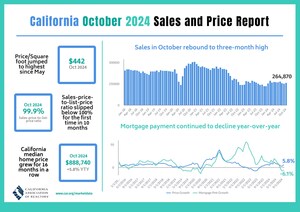Affordability gap for Black and Hispanic/Latino households remains wide
- Less than one in five of all Californians earned enough income to support the purchase of an $813,980 statewide median-priced home in 2023, down from just over one in five from 2022.
- By ethnic groups, about one-fifth of White California households and less than one in 10 Black and Hispanic/Latino California households could afford the same median-priced home, while 28 percent of Asians could buy a median-priced home.
- Assuming a 20 percent down payment on a $813,890 median-priced home, a minimum annual income of $204,800 was needed to make monthly payments of $4,190, including principal, interest, and taxes at 30-year fixed-rate mortgage at a 6.66 percent interest rate.
LOS ANGELES, April 11, 2024 /PRNewswire/ -- Housing affordability continued to deteriorate for all ethnic home-buying groups last year as interest rates rose higher and the typical mortgage payment for a median-priced home climbed from a year ago, the CALIFORNIA ASSOCIATION OF REALTORS® (C.A.R.) said today.
Eighteen percent of all Californians earned the minimum income needed to purchase a home in 2023, down from 21 percent in 2022. At the same time, housing affordability for White/non-Hispanic households fell from 25 percent in 2022 to 21 percent in 2023. Nine percent of Black and Hispanic/Latino households could afford the same median-priced home in 2023, down from 11 percent for both ethnic groups. The significant difference in housing affordability for Black and Hispanic/Latino households illustrates the homeownership gap and wealth disparity for communities of color, which could worsen as the economy slows and rates remain elevated in 2024. Housing affordability was better for Asians but also declined from the prior year, with the index registering 28 percent of Asian homebuyers who could afford the median-priced home in 2023, down from 32 percent in 2022, according to C.A.R.'s Housing Affordability Index.
Housing affordability gaps narrowed last year but remained wide as interest rates continued to climb while home prices stayed relatively flat. The affordability gap between Blacks and the overall population in California improved from 9.7 percentage points in 2022 to 8.5 percentage points in 2023, and the gap for Hispanics/Latinos improved from 9.6 percentage points in 2022 to 8.9 percentage points in 2023.
According to the Census Bureau's American Community Survey, the 2022 homeownership rate for all Californians was 54 percent, 64 percent for non-Hispanic Whites, 59 percent for Asians, 45 percent for Hispanics/Latinos and 35 percent for Blacks.
With Black and Latino households having much less wealth than the national average, C.A.R. last year urged the state to fully fund the California Dream For All Shared Appreciation Loan assistance program, which provides a loan for 20 percent of the home purchase price, in the California 2023-2024 state budget. This program will help bridge down payment and closing cost hurdles that people of color often experience more acutely and allow many working Californians to get on the housing ladder and gain the benefits of homeownership.
Additionally, in an effort to address California's growing housing affordability crisis and racial homeownership divide, C.A.R. has partnered with nonprofit housing organizations to provide closing cost grants up to $10,000 for eligible first-time home buyers from an underserved community. Since 2022, C.A.R.'s Housing Affordability Fund's Pathway to Homeownership Closing Cost Assistance grant program has provided closing cost grants totaling $2 million for 208 first-time home buyer households from an underserved community throughout California. By the end of 2024, C.A.R. expects to have provided a total of $3 million to more than 300 first-time home buyer households since inception of the Pathway to Homeownership Closing Cost Assistance program.
A minimum annual income of $204,800 was needed to qualify for the purchase of a $813,980 statewide median-priced, existing single-family home in 2023. The monthly payment, including taxes and insurance on a 30-year, fixed-rate loan, would be $4,190, assuming a 20 percent down payment and an effective composite interest rate of 6.66 percent. The 2023 California median income for Whites was $103,870, $120,630 for Asians, $75,950 for Hispanics/Latinos and $63,800 for Blacks — an income gap of nearly one-third that of the overall population, which was $92,420.
C.A.R.'s Housing Affordability Index (HAI) measures the percentage of households that can afford to purchase a median-priced, single-family home in California. C.A.R. also reports affordability indices for regions and select counties within the state. The index is considered the most fundamental measure of housing well-being for home buyers in the state.
Key points from C.A.R.'s 2023 Housing Affordability by Ethnicity report include:
- Of the major counties for which C.A.R. tracks affordability by ethnicity, the affordability gap between Black and the overall population in 2023 was the largest in Contra Costa (-15 percent), San Francisco (-15 percent) and Fresno (-13 percent) counties. Other counties that had a double-digit affordability gap for Black households include Alameda (-12 percent), Santa Clara (-10 percent) and San Mateo (-10 percent). The affordability gaps between Black and the overall population at the state and the nation were -9 percent and -14 percent, respectively.
- For Hispanic/Latino households, the affordability gap was the biggest in Santa Clara (-11 percent), Contra Costa (-10 percent), Alameda (-9 percent) and Solano (-9 percent). The affordability gaps between Hispanic/Latino and the overall population at the state and the nation were -9 percent and -7 percent, respectively.
- At an affordability index of 6 percent, San Francisco and San Diego were the least affordable counties for Black households, while Kern and San Joaquin were the most affordable counties at 29 percent and 24 percent, respectively.
- The least affordable counties in 2023 for Hispanic/Latino homebuyers were Los Angeles (7 percent) and Orange County (7 percent), and the most affordable was Kern at 29 percent.
- For Asian households, Orange County was also the least affordable, with 15 percent earning the minimum income required to buy a median-price home. Kern was the most affordable county with 55 percent of Asian households having the minimum income required to buy a median-priced home.
- Orange County was the least affordable county for non-Hispanic White households, with 16 percent earning the minimum income required to buy a median-price home. Fresno was the most affordable at 43 percent.
Leading the way…® in California real estate for more than 118 years, the CALIFORNIA ASSOCIATION OF REALTORS® (www.car.org) is one of the largest state trade organizations in the United States with more than 200,000 members dedicated to the advancement of professionalism in real estate. C.A.R. is headquartered in Los Angeles.
CALIFORNIA ASSOCIATION OF REALTORS®
2023 Traditional Housing Affordability Index by Ethnicity
2023 |
C.A.R. Traditional Housing Affordability Index |
|||||||
STATE/REGION/COUNTY |
All |
White, |
Asian |
Hispanic/ |
Black |
Median |
Monthly |
Minimum |
Calif. Single-family homes |
18 |
21 |
28 |
9 |
9 |
$813,980 |
$4,186 |
$204,800 |
Calif. Condo/Townhomes |
26 |
31 |
38 |
16 |
15 |
$640,000 |
$3,291 |
$161,200 |
United States |
38 |
41 |
54 |
31 |
24 |
$394,100 |
$2,027 |
$99,200 |
San Francisco Bay Area |
||||||||
Alameda |
19 |
21 |
25 |
10 |
7 |
$1,225,000 |
$6,299 |
$308,400 |
Contra Costa |
25 |
29 |
35 |
15 |
11 |
$850,000 |
$4,371 |
$214,000 |
San Francisco |
21 |
26 |
18 |
17 |
6 |
$1,562,500 |
$8,035 |
$393,200 |
San Mateo |
17 |
19 |
20 |
10 |
8 |
$1,960,000 |
$10,079 |
$493,200 |
Santa Clara |
20 |
21 |
25 |
8 |
9 |
$1,765,000 |
$9,076 |
$444,400 |
Solano |
27 |
30 |
39 |
18 |
22 |
$586,000 |
$3,013 |
$147,600 |
Southern California |
||||||||
Los Angeles |
14 |
22 |
18 |
7 |
8 |
$833,380 |
$4,285 |
$209,600 |
Orange |
13 |
16 |
15 |
7 |
7 |
$1,260,000 |
$6,479 |
$317,200 |
Riverside |
23 |
26 |
30 |
18 |
20 |
$612,000 |
$3,147 |
$154,000 |
San Bernardino |
31 |
34 |
41 |
27 |
23 |
$475,000 |
$2,443 |
$119,600 |
San Diego |
14 |
16 |
21 |
8 |
6 |
$931,200 |
$4,788 |
$234,400 |
Central Valley |
||||||||
Fresno |
33 |
43 |
39 |
26 |
20 |
$410,000 |
$2,108 |
$103,200 |
Kern |
34 |
39 |
55 |
29 |
29 |
$379,000 |
$1,949 |
$95,200 |
Sacramento |
28 |
30 |
34 |
23 |
21 |
$527,086 |
$2,710 |
$132,800 |
San Joaquin |
29 |
32 |
38 |
21 |
24 |
$535,000 |
$2,751 |
$134,800 |
Stanislaus |
19 |
24 |
19 |
14 |
15 |
$460,000 |
$2,365 |
$115,600 |
* Assumes 20 percent downpayment
SOURCE CALIFORNIA ASSOCIATION OF REALTORS® (C.A.R.)

WANT YOUR COMPANY'S NEWS FEATURED ON PRNEWSWIRE.COM?
Newsrooms &
Influencers
Digital Media
Outlets
Journalists
Opted In






Share this article